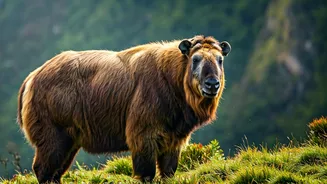Appearance and Characteristics
The Takin, also called the cattle chamois, is a large mammal with a distinctive appearance. It showcases a robust physique and a dense, shaggy coat that
helps them survive in cold, mountainous habitats. Their appearance often varies depending on the subspecies, leading to a range of coat colors from golden to blackish-brown. One of the unique features of the Takin is its large, arched nose, contributing to its somewhat comical expression. Their sturdy legs and cloven hooves are perfectly designed for navigating steep terrain. They possess a thick, muscular neck and broad chest, providing additional strength. The Takin is well-adapted to high-altitude environments, with their body structure and coat helping to maintain body temperature in harsh conditions. These features give the Takin a unique appearance that helps distinguish it from other animals in its range, making it a truly exceptional mammal.
Habitat and Distribution
Takins inhabit the eastern Himalayas and adjacent regions, including parts of Bhutan, China, India, and Myanmar. They favor steep, forested valleys and alpine meadows, typically found at elevations between 2,000 to 4,500 meters. The geographical spread of Takins depends on the subspecies. They are well-adapted to the rugged terrain of their surroundings. These animals migrate seasonally. During the warmer months, they move to higher altitudes to take advantage of fresh grazing, and during the colder months, they descend to lower elevations. This migration is vital for survival, allowing them to access food and shelter, while the geographical distribution highlights their adaptation to a variety of climates and landscapes in the Himalayan region.
Dietary Habits Explained
Takins are primarily herbivores, their diet consisting mainly of grasses, herbs, leaves, and shoots. They are opportunistic feeders, adjusting their diet based on seasonal availability. In the summer, they graze on a wide variety of alpine plants in the high-altitude meadows. During winter, their diets shift. They consume evergreen leaves and other available vegetation. Takins have developed specialized digestive systems to process tough plant matter. Their rumination process allows them to extract maximum nutrients from their food. This dietary adaptation allows Takins to flourish in environments with seasonal variations in food availability. Their dietary flexibility, in turn, helps them to survive, contributing to their survival in challenging environments.
Social Structure and Behavior
Takins are known for their social behaviors, often living in herds. The size of these herds varies depending on the season and environmental conditions. During the summer, herds can grow, sometimes including several dozen individuals. In winter, Takins often form smaller groups for protection and easier access to food. They have a complex social hierarchy that is typically managed by the largest males, although this dynamic may shift with the season and social structure. These animals communicate through various vocalizations and scent-marking. They also have an instinct to flee towards safety when faced with potential threats, ensuring their preservation. The social cohesion and communication skills that Takins possess help them to navigate their environment safely and effectively.
Conservation Status Analysis
The conservation status of the Takin varies by subspecies. The International Union for Conservation of Nature (IUCN) classifies the Takin as vulnerable. This classification reflects ongoing threats, which include habitat loss and human disturbances. Poaching for meat and other body parts also poses a significant risk to their population, reducing their numbers. Despite these threats, conservation efforts are underway. Protected areas and conservation programs are being established across their habitat. These initiatives aim to safeguard Takin populations and their habitats. Monitoring of populations and research of their behavior are key to the design of the conservation strategies. The continuation of conservation actions will be essential in ensuring the long-term survival of the Takin.
Cultural Significance Noted
Takins hold cultural importance in many Himalayan communities, especially Bhutan and China. They are often associated with local myths and legends, representing strength and resilience. In Bhutan, the Takin is the national animal. This reflects its importance in the country's identity. Traditional knowledge, including the animal’s behaviors, also contributes to their conservation. Local communities often participate in conservation programs and help protect the Takin. The animal is also depicted in various artistic forms, including paintings and sculptures, showing the cultural connection. These associations reflect the deep-rooted cultural connections between the Takin and the Himalayan communities, and also highlight the need for its continuous conservation.















